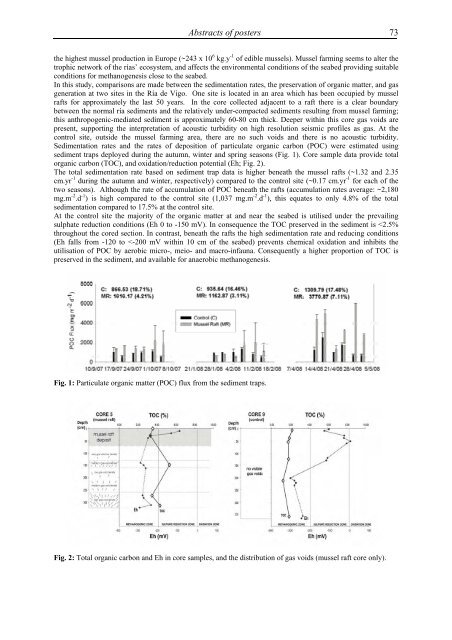Ninth international conference on - Marum
Ninth international conference on - Marum
Ninth international conference on - Marum
You also want an ePaper? Increase the reach of your titles
YUMPU automatically turns print PDFs into web optimized ePapers that Google loves.
Abstracts of posters 73<br />
the highest mussel producti<strong>on</strong> in Europe (~243 x 10 6 kg.y -1 of edible mussels). Mussel farming seems to alter the<br />
trophic network of the rías’ ecosystem, and affects the envir<strong>on</strong>mental c<strong>on</strong>diti<strong>on</strong>s of the seabed providing suitable<br />
c<strong>on</strong>diti<strong>on</strong>s for methanogenesis close to the seabed.<br />
In this study, comparis<strong>on</strong>s are made between the sedimentati<strong>on</strong> rates, the preservati<strong>on</strong> of organic matter, and gas<br />
generati<strong>on</strong> at two sites in the Ría de Vigo. One site is located in an area which has been occupied by mussel<br />
rafts for approximately the last 50 years. In the core collected adjacent to a raft there is a clear boundary<br />
between the normal ría sediments and the relatively under-compacted sediments resulting from mussel farming;<br />
this anthropogenic-mediated sediment is approximately 60-80 cm thick. Deeper within this core gas voids are<br />
present, supporting the interpretati<strong>on</strong> of acoustic turbidity <strong>on</strong> high resoluti<strong>on</strong> seismic profiles as gas. At the<br />
c<strong>on</strong>trol site, outside the mussel farming area, there are no such voids and there is no acoustic turbidity.<br />
Sedimentati<strong>on</strong> rates and the rates of depositi<strong>on</strong> of particulate organic carb<strong>on</strong> (POC) were estimated using<br />
sediment traps deployed during the autumn, winter and spring seas<strong>on</strong>s (Fig. 1). Core sample data provide total<br />
organic carb<strong>on</strong> (TOC), and oxidati<strong>on</strong>/reducti<strong>on</strong> potential (Eh; Fig. 2).<br />
The total sedimentati<strong>on</strong> rate based <strong>on</strong> sediment trap data is higher beneath the mussel rafts (~1.32 and 2.35<br />
cm.yr -1 during the autumn and winter, respectively) compared to the c<strong>on</strong>trol site (~0.17 cm.yr -1 for each of the<br />
two seas<strong>on</strong>s). Although the rate of accumulati<strong>on</strong> of POC beneath the rafts (accumulati<strong>on</strong> rates average: ~2,180<br />
mg.m -2 .d -1 ) is high compared to the c<strong>on</strong>trol site (1,037 mg.m -2 .d -1 ), this equates to <strong>on</strong>ly 4.8% of the total<br />
sedimentati<strong>on</strong> compared to 17.5% at the c<strong>on</strong>trol site.<br />
At the c<strong>on</strong>trol site the majority of the organic matter at and near the seabed is utilised under the prevailing<br />
sulphate reducti<strong>on</strong> c<strong>on</strong>diti<strong>on</strong>s (Eh 0 to -150 mV). In c<strong>on</strong>sequence the TOC preserved in the sediment is














